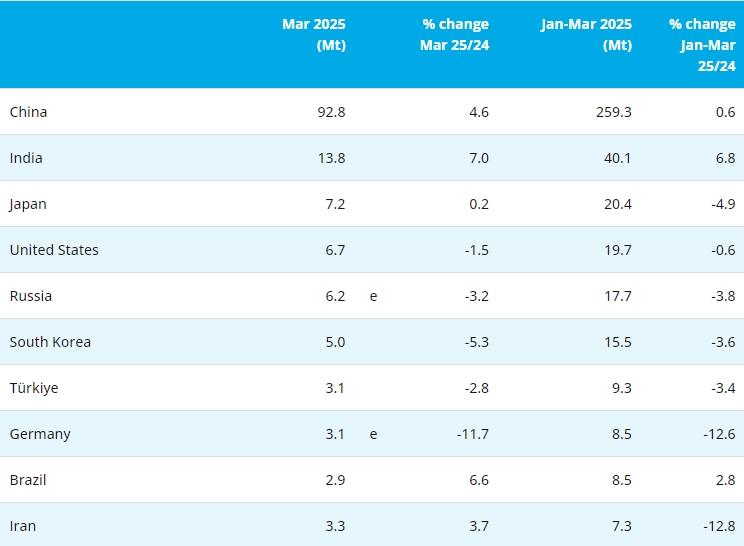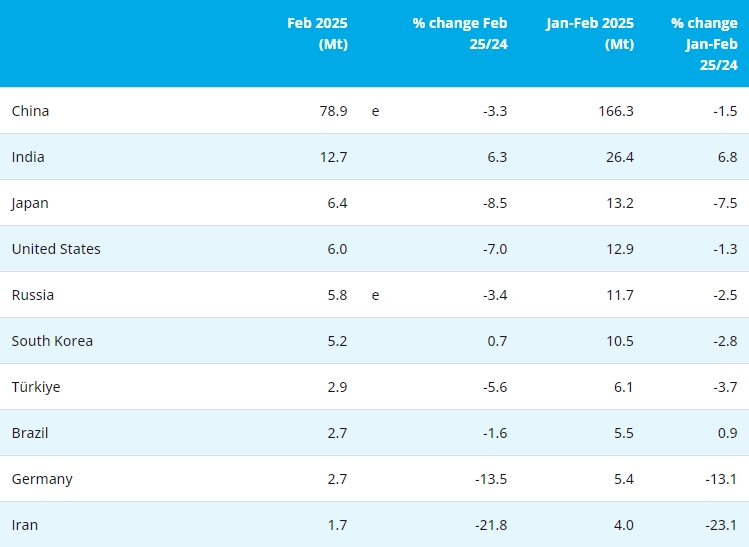
|
Salient Statistics—United States:
|
2017 |
2018 |
2019 |
2020 |
2021 e |
|
Production: |
|
|
|
|
|
|
Mine |
22,100 |
17,600 |
13,500 |
16,700 |
18,000 |
|
Refinery, byproduct |
W |
W |
W |
W |
W |
|
Imports: |
|
|
|
|
|
|
Ores and concentrates |
64 |
3 |
4 |
95 |
24 |
|
Primary |
150,000 |
144,000 |
119,000 |
105,000 |
110,000 |
|
Secondary |
38,100 |
45,100 |
37,700 |
31,800 |
35,000 |
|
Exports: |
|
|
|
|
|
|
Ores and concentrates |
20,000 |
18,000 |
14,300 |
13,400 |
15,000 |
|
Primary |
11,000 |
9,780 |
12,800 |
11,300 |
10,000 |
|
Secondary |
51,500 |
59,400 |
47,800 |
34,100 |
29,000 |
|
Consumption: |
|
|
|
|
|
|
Reported, primary |
105,000 |
107,000 |
105,000 |
e84,000 |
82,000 |
|
Reported, secondary, purchased scrap |
133,000 |
123,000 |
111,000 |
e99,000 |
110,000 |
|
Apparent, primary1 |
140,000 |
136,000 |
106,000 |
94,100 |
100,000 |
|
Apparent, total2 |
273,000 |
259,000 |
217,000 |
e190,000 |
210,000 |
|
Price, average annual, London Metal Exchange (LME), cash: |
|
|
|
|
|
|
Dollars per metric ton |
10,403 |
13,114 |
13,903 |
13,772 |
18,000 |
|
Dollars per pound |
4.719 |
5.948 |
6.306 |
6.25 |
8.3 |
|
Stocks, yearend: |
|
|
|
|
|
|
Consumer
|
14,600 |
16,300 |
13,400 |
13,000 |
13,000 |
|
LME U.S. warehouses |
3,780 |
2,268 |
1,974 |
1,734 |
1,500 |
|
Net import reliance3 as a percentage of total apparent consumption |
51 |
52 |
49 |
49 |
48 |
|
Tariff: Item
|
Number
|
Normal Trade Relations 12–31–21
|
|
Nickel ores and concentrates, nickel content |
2604.00.0040 |
Free. |
|
Ferronickel |
7202.60.0000 |
Free.
|
|
Unwrought nickel, not alloyed |
7502.10.0000 |
Free.
|
|
Nickel waste and scrap |
7503.00.0000 |
Free.
|
|
Nickel powders |
7504.00.0010 |
Free.
|
|
Nickel flakes |
7504.00.0050 |
Free.
|
|
|
|
FY 2021
|
FY 2022
|
||
|
Material
|
Inventory as of 9–30–21
|
Potential acquisitions
|
Potential disposals
|
Potential acquisitions
|
Potential disposals
|
|
Nickel alloys, gross weight
|
790 |
— |
— |
— |
— |
|
|
Mine production |
Reserves5
|
|
|
|
2020 |
2021 |
|
|
United States |
16,700 |
18,000 |
6340,000 |
|
Australia |
169,000 |
160,000 |
721,000,000 |
|
Brazil |
77,100 |
100,000 |
16,000,000 |
|
Canada |
167,000 |
130,000 |
2,000,000 |
|
China |
120,000 |
120,000 |
2,800,000 |
|
Indonesia |
771,000 |
1,000,000 |
21,000,000 |
|
New Caledonia8 |
200,000 |
190,000 |
NA |
|
Philippines |
334,000 |
370,000 |
4,800,000 |
|
Russia |
283,000 |
250,000 |
7,500,000 |
|
Other countries |
373,000 |
410,000 |
20,000,000 |
|
World total (rounded) |
2,510,000 |
2,700,000 |
>95,000,000 |
- [Editor:Alakay]



 Save
Save Print
Print Daily News
Daily News Research
Research Magazine
Magazine Company Database
Company Database Customized Database
Customized Database Conferences
Conferences Advertisement
Advertisement Trade
Trade














 Online inquiry
Online inquiry Contact
Contact

Tell Us What You Think